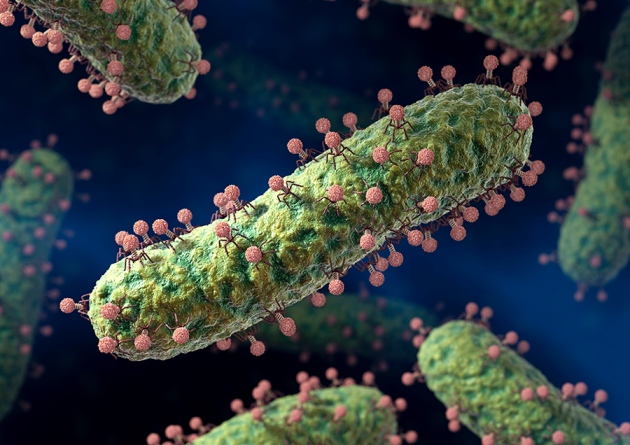In this article we will discuss about the (1) Classification of bacteriophage (2) Types of Bacteriophages.
Essay # (1) Classification of bacteriophage
A. Genome is double-stranded DNA, generally linear.
1. Family Myoviridae:
Icosahedral, isometric or elongated head with a helical rigid tail containing a contractile sheath, tail plate, tail fibres and spikes.
Example: E. coli phage (coliphage) T2, T4, T6.
2. Family Styloviridae:
Icosahedral, isometric head with a long flexible tail without a contractile sheath. Tail fibres may or may not be present.
Example: E. coli phage T1, T5.
3. Family Pedoviridae:
Icosahedral, isometric head with a sheath-less tail which is shorter than the head. Tail fibres may or may not be present.
Example: E. coli phage T3, T7.
4. Family Corticoviridae:
Icosahedral, isometric head without a tail. Capsid contains lipid in addition to protein. The genome is closed circular ds-DNA.
Example: Pseudomonas phage MP2.
5. Family Tectiviridae:
Icosahedral, isometric head without tail. Virion contains double capsid.
Example: phage PRD 1.
6. Family Plasmaviridae:
Virion plemorphic, Enveloped.
Example: Phage MV-L2.
B. Genome single-stranded DNA:
1. Family Microviridae:
Icosahedral, isometric head without tail or envelope.
Example: E. coli phage φX174 having a circular ss-DNA genome.
2. Family Inoviridae:
Helical symmetry; virions long rod shaped or filamentous; non-enveloped; genome circular ss-DNA.
Example: E. coli phage fd and bacteriophage MV-L1.
2. Bacteriophages with RNA Genome:
A. Genome double-stranded RNA
1. Family Cystoviridae:
Capsid icosahedral, enveloped; ds-RNA is segmented; virions more or less spherical, about 90-100 nm in diameter.
Example: Phage φ6.
B. Genome single-stranded RNA
1. Family Leviviridae:
Capsid icosahedral, non-enveloped, ss-RNA is linear (+). Virions 26-27 nm in size.
Example: Phages MS2 and Qβ.
Morphology of some representative bacteriophages is shown diagrammatically in Fig. 6.10:
Essay # (2) Types of Bacteriophages:
The phages have specific host. E. coli has been studied most extensively from this point of view. The bacteriophage capable of destroying E. coli is called coli-phage. The types of coli-phages have been called as T-phages.
They have been classified into many arbitrary groups such as:
(i) T-Even Phages (T2, T4, T6):
These phages have an angular head and contractile tail. The DNA contain a unique base 5-hydroxyl methyl cytosine in place of cytosine. These viruses are most thoroughly studied viruses. These are also called virulent as they cause death of the host cells.
(ii) T-Odd Phages (T1, T3, T7):
These viruses have an angular head and a short non-contractile tail. The DNA contain cytosine. These are temperate viruses as their genetic material becomes integrated with bacterial chromosomes and the host remains unaffected.
(iii) T5 Phages:
These viruses have an angular head and non-contractile tail. The DNA of these viruses also contains cytosine.
Bacteriophage : Classification and Types of Bacteriophages | Microbiology
![Bacteriophage : Classification and Types of Bacteriophages | Microbiology]() Reviewed by Rajkumar
on
October 30, 2017
Rating:
Reviewed by Rajkumar
on
October 30, 2017
Rating:


No comments: